
Take it with humor: The ups and downs of interdisciplinary work. Swen Seebach's and Stella Veciana's comic series created out of the experience of the Synergy-Workshop in HANGAR, Barcelona 2013.
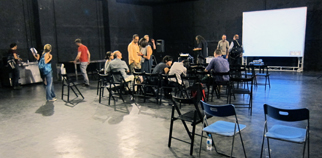
Workshop Synergy: Interdisciplinary Practice and Theory, Hangar, Barcelona. 28th to 30th of June. (Photo: Stella Veciana).
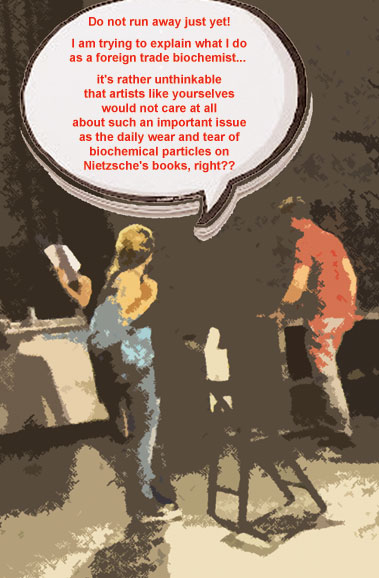
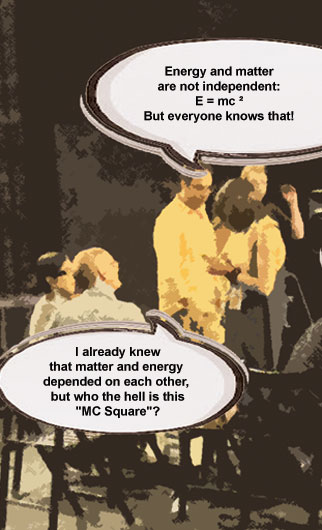
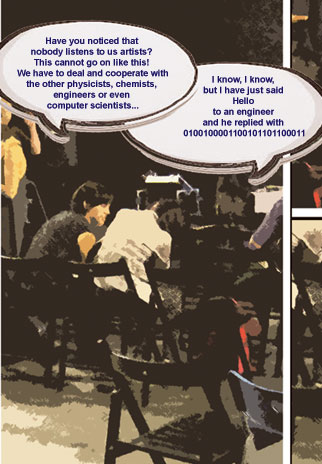
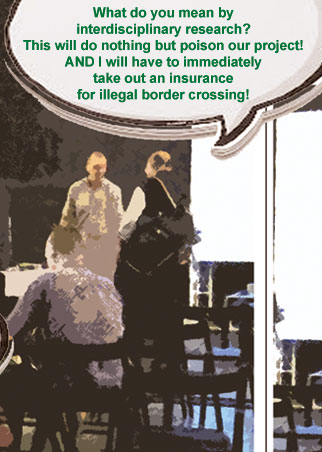
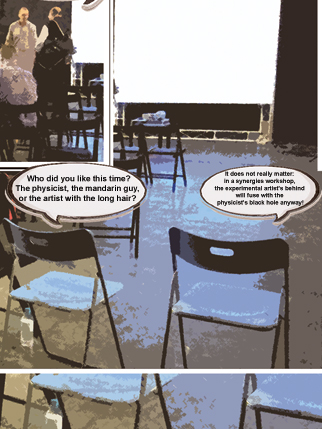
Take it with humor: The ups and downs of interdisciplinary work. Swen Seebach's and Stella Veciana's comic series created out of the experience of the Synergy-Workshop in HANGAR, Barcelona 2013.
|
A physicist, a sociologist and an artist come into a bar... - What are the possible roles of humour in different forms of interdisciplinary projects?
Swen Seebach
Near the end of July 2013, HANGAR, a cultural centre based in Barcelona, organised a workshop »Synergy: Interdisciplinary Practice and Theory«. The workshop was a part of the Soft Control project, an interdisciplinary project funded by the Cultural Program of the European Union. One aim of the workshop was the creation of a workshop protocol, a master document, which should help develop methods to improve interdisciplinary workshops and interdisciplinarity in general. Another aim was to put the ideas and thoughts from this protocol into practice, by crystallising them within interdisciplinary projects developed by the participants of the workshop, or, to express it in rather Marxist terms, by objectifying the thoughts developed in the workshop through the collective work of people.
Within the workshop, I played the role of an “observer of the second order”, as in Luhmann’s[1] famous system theory: an observer of the second order isn’t someone who looks at the other participants from the position of a participant; he isn’t someone who defines his or her position in the workshop according to its participatory role in the group, but who instead, as someone looking at them from a distance, has the capability to understand their actions and interrelations in a different, more global, and less projective way.
Evidently, the role of the observer of the second order is usually a role which a social scientist or an anthropologist is in a best position to fill. And obviously I am counting myself as part of this “species”, belonging to this category of beings. However, instead of giving an account on the role of I in the workshop, and the role of the observer in workshops in general, the meaning of this little reflection wants to serve to reflect on the others, the participants in the workshop, on their actions and interactions, and on the dynamics of the group within the workshop. As a result of these reflections this text wants to systemise, the different forms and bonds weaved by the means of the concrete interrelationships in the workshop, and to crystallise them in Ideal types. Furthermore, this text will use the example of humour in order to show and visualise different forms of interdisciplinarity and the meaning of shared experiences that make interdisciplinarity work.
A few more words on the observer of the second order. As an observer of the second order you experience a workshop differently from other participants. Although taking part in the same events, I was not completely immersed in them, on the contrary. Metaphorically speaking, one could say that I have seen the processes, events, actions and interactions in the workshop like someone “observing a river from a mooring site”, whilst the others, the participants are the event itself, “they and their interplay are the river”. Much more could indeed be said about the advantages and disadvantages of observing a workshop as a participant and as an observer of the second order but this is not the place.
Therefore, let’s return to the Synergy workshop in HANGAR. Motivated and interested interdisciplinary workshop participants had been invited to the workshop. There were scientists from all fields, including physics (e.g. Ramon Sangüesa, Irene Lapuente, Josep Perelló), biology (e.g. Ramon Guardans), medicine and biomedicine (e.g. Raimund Fickert), engineering (like Fernando Vilaraño, Irma Vila), Informatics (Ramon Sangüesa), as well as participants from the disciplines of fine arts and digital arts (like Stella Veciana, Simon Penny, Roc Parés, Mocksim und Dan Norton). The selection itself was already something interesting to reflect upon. More or less surprisingly no one apart from myself seemed to come from a social science background. Maybe this was because social sciences as a whole generally represent rather overlapping disciplines,where borders are often blurred. Therefore to do something interdisciplinary with fields with which there is so very little common disciplinary ground seems on the face of it rather unattractive. Well, I don’t know. Apart from myself, there was another participant with at least some social science background (Mara Balestrini). However, her role in the workshop rather departed from that of a social scientist.
The workshop took place in a room with no daylight or windows, similar to a bunker, but in Freudian terms we could also think of it as a giant Uterus, which is destined to give light to something. Maybe that is why, from the beginning, the whole event appeared to unfold as a big ritual, a ritual of passage transforming the participants from their original selves into something else, creating something new out of the “spiritual interplay” between us.
While on the first day, everything turned around getting to know each other, on the second day we dived straightaway into deep reflections on interdisciplinarity. Simon Penny, Roc Parés and Mara Balestrini worked hard to make us think about, and feel, what interdisciplinary work might mean, and what it might look like.
However, in the first presentations given by these three interdisciplinary experts invited by Hangar, it quickly became apparent that what is usually called interdisciplinary is not always interdisciplinary, at least not in the same way. There is no such thing as a one-concept, one-definition “interdisciplinarity”. What I mean by this hopefully becomes much clearer when we look at some symptomatic examples. Looking for example at Theo Jansens’ Strandbeest or at Roc Pares’ digital art works (e.g. Ball del Fanalet - Dance of the Lantern, together with Narcis Pares), we realise that these works must surely be interdisciplinary, however fundamentally different from Mara Balestrini’s work with city planners, or from the work in an Urban Lab.
They, in turn, are different from interdisciplinary work in which one discipline needs another discipline in order to solve a concrete and limited disciplinary problem (e.g. when a cultural centre like HANGAR needs a sociologist in order to work on a protocol for interdisciplinarity). What I mean is that any discussion about interdisciplinarity remains somehow imprecise, when we define the meaning and making of interdiscipliniarity as the haphazard meeting of two or more disciplines in any manner whatsoever. I suggest then, that a further differentiation between different forms of interdisciplinarity is necessary, (a differentiation) which would define the role played by the different disciplines within an interdisciplinary work/project, as well as specify the way in which the disciplines meet and connect.
Based on the observations in the context of the Synergy workshop, I have decided to differentiate between individual interdisciplinarity, hierarchical or instrumental interdisciplinarity, symmetrical interdisciplinarity, and cooperative interdisciplinarity. Each form of interdisciplinarity creates its very own questions, often deals with very different problems and often works best with very different strategies.
Individual interdisciplinarity is the form of interdisciplinary work in which one individual initiates and produces works which are based on interrelating and harmonising (or sometimes not) two or more disciplines. If e.g. an artist has also acquired an education in engineering, and thus works with tools from these two disciplines (art and engineering) on a project, then this is what I would call individual interdisciplinarity. The effort of interrelating disciplines is a purely individual act. The individual who unites in themselves characteristic abilities and capabilities from different disciplines crosses the boundary between disciplines. The tensions and the necessary processes of negotiation and renegotiation between disciplinary processes are harmonised within and by the subject itself. In the workshop the artist was used as one of the most typical examples of an interdisciplinary subject, as much so in theoretical reflections as in the practical part of the workshop.
The second form of interdisciplinarity that I discovered in the workshop is what I would call hierarchical or instrumental interdisciplinarity. Indeed, this is the form of collective interdisciplinary work in which the different co-operators from different disciplines do not operate on the same hierarchical level. If e.g. a physics laboratory contracts a computer scientist in order to solve a clearly defined problem then we have a typical case of hierarchical or instrumental interdisciplinarity. Similarly, it can be said that if a biomedical research centre like the Barcelona Biomedical Research Park (PRBB) contracts artists to mediate the work of the research centre to the public on their open doors day, this is also a typical case of hierarchical or instrumental interdisciplinarity. Interdisciplinarity is created within the framework of the contracting institution's or co-operator's needs (and/or demands). Some negotiations might take place about what is expected and possible in order to create a successful outcome. However, the contracting discipline has the final word about what is and what is not to be done.
This form of interdisciplinary co-operation has really become an important business in its own right, and a quite nice life-line for many academics. There are e.g. an increasing amount of firms that commission anthropologists and sociologist to perform a company analysis of their internal social and socio-technical processes and practices. In fact, my role in the Soft-Control Workshop fitted exactly the description of a hierarchical or instrumental interdisciplinary task.
Interdisciplinarity based on co-operation and symmetrical interdisciplinarity are principally quite similar to each other: both are forms of horizontal intertwining between disciplines. In both forms, two or more partners work together and contribute with their disciplinary expertise. Both forms however differ profoundly on three counts: on the expectation of profitable and beneficial results, on the need to create and work together on the basis of a concrete research question or project, and thirdly on the meaning of power in the process of co-operating.
Symmetrical interdisciplinarity is the form of interdisciplinary work in which two or more scientists from different disciplines come and work together on the basis of the belief (and hope) that all gain an equally-sized piece of the interdisciplinary “cake”. Every scientist must not only have the feeling that the part he contributes and adds to the interdisciplinary work is compensated by the project and the results, but also ideally that this share gained by each scientist has more or less equal size. In this ideal case each project participant would contribute with more or less the same size of knowledge and working hours, and would be able to profit equally like all other participants from the achieved results. Bringing in a similarly sized share and gaining a similarly sized profit, a certain symmetry between the participating scientists is created that allows all of them to feel somehow equal to other participants and somehow independent from them. Through this symmetry the influence of power on the daily work is minimised.
However, in order to create the context by the help of which this symmetry is established, it is necessary to work within a specific project with a clear research question and clear research targets, which are clearly understood by everyone. Just by creating these frame conditions all participants are conscious about their roles, their contributions, their benefits and their possible losses. When frame conditions are set, a relatively easy and flexible interdisciplinary work becomes possible. The process of interdisciplinarisation happens within and with the help of the project. Additionally, it is possible that in the process of working with each other in an interdisciplinary framework, knowledge is created that was neither planned nor expected, which might add further value to the interdisciplinary work.
Interdisciplinarity based on co-operation is the form of interdisciplinary working with each other in which two or more people from different disciplines come and work together, under the condition that they are all ready to sacrifice something in order to work together, without having any guarantees about whether the interdisciplinary work will be useful or valuable, and if so, how valuable it will be. In a certain way, interdisciplinarily working and researching together turns the means to answer certain project-related research questions into an end. Therefore, all participants must be ready to give a part of their time and knowledge to the group. In contrast to symmetric interdisciplinarity, interdisciplinarity based on co-operation does not need a concrete question, a clearly defined project or explicit expectations regarding results. On the other hand, especially if cooperation-based interdisciplinary work turns into a beneficial project, it risks becoming loaded with power and individual interests, which might destroy previously balanced dynamics of the group.
Working together in a cooperation-based interdisciplinary work group demands from all participants a high degree of care/attention, as here, the “collective” work, or even the “collective” being with one another is the only goal of the group. This is also the reason why in such (inter-)relationships, like in other relationships wherein being and doing things together is the only reason for doing them (like in intimate relationships), constant devoted and dedicated care needs to be injected into the cooperation. Disciplines are tied with one another not by the means of scientific questions or matters but by the experience of collective research and companionship in itself.
Having discussed the different forms of interdisciplinarity, it is evident to everyone that these different forms not only exist but that they also shape the behaviour of those participating in interdisciplinary research, something that came to light in the workshop. However, there is one important thing that all forms of interdisciplinarity have in common: in the course of interdisciplinary work, a boundary, the limits of and between the individual disciplines, has to be crossed and perhaps negotiated between them. In the workshop, the question of myself as an observer was raised: how does this happen (this interdisciplinary ford over disciplinary boundaries)? Does this bridging over disciplinary boundaries between all forms of interdisciplinarity share a common denominator?
And whilst I was sitting there in the darkness of the HANGAR Bunker, in this interdisciplinary Uterus the first groups were, or better, got formed. Looking at them, at these little interdisciplinary islands, I realised how everyone moved a little closer together and relaxed a little bit more in those moments in which I heard them laughing. Reflecting about it I realised that this was no accident. Surely they weren't telling the typical interdisciplinary joke:
“An assemblage of the most gifted minds in the world were all posed the following question: "What is 2 * 2 ?"
The chemist says immediately circa 10 to the power 1.
The engineer whips out his slide rule (so it's old) and shuffles it back and forth, and finally announces "3.99".
The physicist consults his technical references, sets up the problem on his computer, and announces "it lies between 3.98 and 4.02".
The mathematician cogitates for a while, oblivious to the rest of the world, then announces: "I don't know what the answer is, but I can tell you, an answer exists!".
Philosopher: "But what do you _mean_ by 2 * 2?"
Logician: "Please define 2 * 2 more precisely."
Accountant: Closes all the doors and windows, looks around carefully, then asks "What do you _want_ the answer to be?"
Computer Hacker: Breaks into the NSA super-computer and gives the answer.
Stress engineer: Well I know it's 4, but let's call it 50 anyway
The psychologist: Why do you wish to know that?
The sociologist: I don't know, but it was nice talking about it.
Behavioral Ecologist: A polygamous mating system.
Medical Student: 4
All others look astonished: How did you know??
Medical Student: I memorized it.”[2]
Even if this form of humour objectifies the problems of interdisciplinarity quite well, and although this form of humour also existed in the workshop, it is not this kind of humour that interests me right now. It is rather that, looking back on it, the whole workshop was somehow guided by humour, a humour that instead of referring to or reflecting on boundaries, helped to overcome them (where a dispute about them might have existed).
That humour is a weapon in order to bridge personal boundaries between individuals and social groups should not come as a surprise. Freud[4] already saw in the joke a force that is able to break with day-to-day realities, and therefore side-step boundaries, by giving people a distance to what they and their world-view is usually based upon. The joke allows people to laugh about the most serious things and thus to overcome them. Nietzsche[5] saw in them a way to exist beyond good and evil. And Berger and Luckmann[6], two important sociologists of the last century, saw in humour a “finite universe of meaning”. And really, to look at humour in interdisciplinary projects in terms of “finite universes of meaning” makes sense. To contextualise, a “finite universe of meaning” is a part of our social life-world which, separated from everyday life, allows to oppose and overcome everyday life judgements and prejudices. That is why “finite universes of meaning” allow a form of meeting and relating to each other beyond any kind of negative social boundary.
Is this the reason why humour helped in Barcelona to build bridges between different participants? Probably. Humour is in general a good means to overcome disciplinary limitations. However, how the form and by whom humour can be used in order to build interdisciplinarity depends on the form of that interdisciplinarity.
In the case of individual interdisciplinarity humour plays a role in the way the interdisciplinary subject deals with himself or herself, with his or her work and with his or her audiences. This humour might be ironic or cynical or is expressed via a project, as we can very often observe in the case of artists. In the case of hierarchical or instrumental interdisciplinarity the meaning and usage of humour is a different issue. Here the leading or contracting discipline and the individuals belonging to this discipline create and shape the frame for possible humour that might or might not be accepted by the others.
In symmetrical interdisciplinary projects, humour helps to create a certain form of interrelatedness beyond the limits of the shared project and the benefits the project generates for everyone. The factually nearly individually instrumental character of working with one another becomes at least temporarily suspended and replaced by a shared experience. However, on a par with the question of results and benefits in projects with symmetrical interdisciplinarity, the investment in humour and the possibility for being humorous has to be relatively equally distributed. Just in the case of equal distribution emotional imbalances are thus avoided, which then might themselves become part of the calculation regarding the economic feasibility of the interdisciplinary co-operation.
In interdisciplinary projects based on co-operation, humour is especially important, as here shared experiences are the very foundation for interdisciplinarily working with one another. This might be the case for any interdisciplinary project but never so directly and strongly as here. As humour creates a finite universe of meaning beyond everyday life, in which we can meet, act and interact together more easily, and exactly because these universes are beyond the everyday order; as we experience these shared moments as especially intensive and bonding, humour is a perfect means with which to create and maintain an interdisciplinary tie, especially if this bond develops in a cooperation-based project. Laughing together engenders a collective experience that creates shared memories and stimulates the desire for more.
In the workshop people weaved social threads by the means of humour, and they also negotiated hierarchies. Humour was an important element, holding the whole event and the participants together, even when the official workshop had already done that. The interdisciplinary shamans of HANGAR's the rite of passage - Roc Parés, Simon Penny and Mara Balestrini - played an important role. They directed and channelled the use of humour, the entry into and the exit from these finite humorous universes of meaning. It should come to no surprise that they, experts in interdisciplinary work, are individual interdisciplinaries, individual crossers of boundaries. All three managed in their very own way, opened and limited the worlds we entered, sometimes with humour, but also by imposing norms and standards on participants’ actions and humour uses.
We laughed about the interdisciplinary meaning of eels: „Life itself is a succession of eels”, a phrase cited by Simon Penny, however not remembering what he wanted to say by it. We laughed about the healing forces of organic „All-Salt“, a salt enriched with all kinds of medicine that as a product, ironically reflects pharmaceutical industrial practices, environmental pollution, the organic discourse, and late modern capitalism. And we laughed about Roc Parés’ openly fought struggle with himself about whether he wanted to be a facilitator or a troublemaker in the workshop.
Resuming, I would defend the thought that interdisciplinarity and interdisciplinary work are potentially possible, even when a physicist, a sociologist and an artist come into a bar. In HANGAR this possibility had become a reality despite different concepts of interdisciplinarity and despite the different interdisciplinary logics, and the different form of interdisciplinarity. Humour had definitely played a part in building bridges.
↑ 1. Niklas Luhmann, Soziale Systeme. Grundriß einer allgemeinen Theorie. Suhrkamp, Frankfurt am Main 1984, neue Auflage 2001.
↑ 2. Link: http://jcdverha.home.xs4all.nl/scijokes/6.html (13.10.2013)
↑ 3. Sigmund Freud: Der Witz und seine Beziehung zum Unbewußten. Fischer Taschenbuch-Verlag, Frankfurt am Main 1986.
↑ 4. Friedrich Nietzsche: Also sprach Zarathustra. Schmeitzner, Chemnitz 1883.
↑ 5. Peter L. Berger, Thomas Luckmann: Die gesellschaftliche Konstruktion der Wirklichkeit. Eine Theorie der Wissenssoziologie. 3. Aufl., Fischer Taschenbuchverlag, Frankfurt a.M. 1972 (1970).
comment |